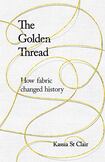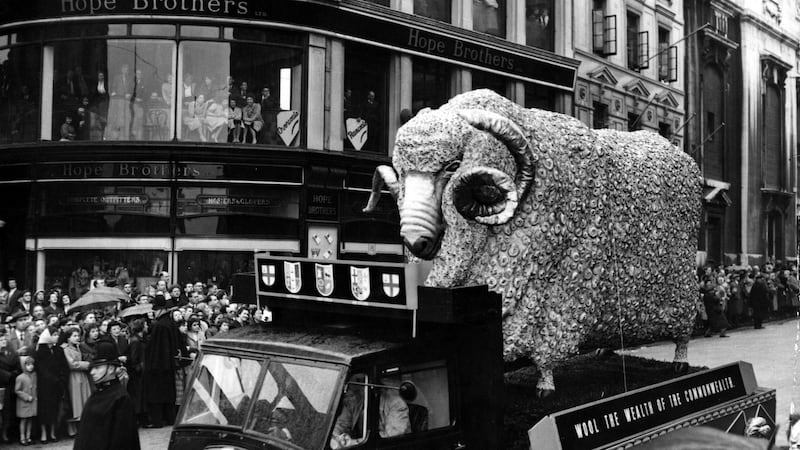
When the English archaeologist Howard Carter discovered the royal tomb of Tutankhamen in Egypt in November 1922, it took fully eight days to unwrap the mummified body of the young king from 16 layers of linen. To get at the body, amulets and jewellery among the bandages, ever more violent methods were employed by Carter and his team; heated knives prised the golden mask from the decapitated skull. The linen, however, was considered by Carter an impediment to be brushed aside, an opinion that would have horrified the ancient Egyptians to whom linen was imbued with powerful even magical meaning. Mummification was associated in their art with the divine. It was what made mummies sacred.
This is just one of the many illuminating stories contained in The Golden Thread, a thematic history of fabrics by design and culture writer Kassia St Clair who points out that the world's earliest fabrics were made by human hand 34,000 years ago. Human ingenuity in transfiguring flax, wool, cotton, silk and hemp into thread was, and still remains, a technological feat requiring skill and tools. Making cloth meant making money. "Weavers take the intertwined threads. . . and create a strong fabric which is exactly what the global distributed network of computers creating the Bitcoin Blockchain does", according to David Orban arguing that weaving is a better metaphor for bitcoin than mining.
Social strata, St Clair emphasises, have long been codified using cloth – luxurious display was a way of expressing power. Language and cloth are interwoven – the interface between text and textile is fertile ground for literary critics who “unpick”, “piece together” or “unravel” while other phrases are also rooted in textile crafts like “being on tenterhooks” or “a knotty problem” or “being spun a yarn”.
The Silk Road
As fascinating as the facts and stories about linen, those about cotton and silk are no less revealing. Silk was power in China but the ancient Romans regarded silk as decadent and saw seeds of destruction in such luxury. The philosopher Seneca fumed that it was imported “so that our married women can show as much of their bodies to the people in the street as they display to their lovers in the bedroom”.
On the western fringes of the Silk Roads, however, it was the Vikings who commanded power with their ability to trade over long distances using waterways rather than roads. Modern sails are made of synthetic fabrics, but those of the Viking longboats that made the near miraculous voyages were woven from linen, cotton, hemp and wool. Scraps of fabric found in northern Norway in 1989 revealed woollen cloth from a sail hundreds of years old.
Like silk, wool was a money spinner in Europe and made, amongst others, the Cistercian Order rich. “The wool trade made them wealthy in the 12th and 13th century and also made them worldly”, comments St Clair. Wool encouraged speculation and profiteering and widened the gap between the richest and poorest.

Lace has its own intricate history and cult status. A craft associated with women and incredibly complex designs passed down the generations, it was a luxury used to display wealth, taste and rank. Its value as a social signifier lay in its delicacy, its making and its expense as images from the 16th and 17th century portraits and Vermeer's famous painting The Lacemaker illustrate all too well.
The pre-eminent fabric of the west, however, was cotton. The story of cotton, the fortunes made and the horror of the African slave market and the fact that from the 1790s to the 1860s, the lives of many millions of American slaves were determined by the demands of king cotton, are well detailed. Even today cotton clothing makes shocking demands on the environment, a single pair of jeans requires 11,000 litres of water.
Rayon’s sordid history
Extreme conditions are another test of fabrics and St Clair has collated many examples on how clothing was used in Everest expeditions and in space research. The Omega suit for Nasa, for instance, was made using Playtex technology from women’s underwear. She also shows how clothing and serious sport can be contentious, citing arguments over swimsuits at the Olympics.
Probably the most disturbing chapter is the one on rayon, a synthetic fabric that has names like artificial silk, viscose, bamboo or modal. It has a sordid history of forced labour, heavy dangerous chemicals used and horrific medical hazards faced by factory workers. Today’s mass market fashion brands rely on synthetic fabrics which are cheap and quick to produce, but the human cost is high as the tragedy of Rana Plaza, a building in Bangladesh that collapsed killing 1,135 people in 2013, only too chillingly demonstrated. The building housed five garment factories supplying products for western retailers including Benetton, Walmart and Primark.
Synthetics now make up well over 60 per cent of the global fibre market and polyester derived from crude oil, sheds plastic filaments which are the most abundant environmental debris in the world.
The book concludes that the fabrics we choose and where we get them from still have consequences on the lives of those who produce them. Currently there are futuristic efforts to commercialise spider silk in the US, Germany and Japan, but St Clair’s account of visiting such a factory is just another one of the many vivid tales spun with such style in this utterly riveting history.











